


The Biden administration has released “over 300,000” unaccompanied immigrant children into the United States after they crossed the border illegally, the head of the Department of Health and Human Services admitted to concerned House Republicans Wednesday.
Republicans grilled HHS Secretary Xavier Becerra for details on the extent to which immigrant children have come over the border and been released into the country, including to unrelated adults, rather than being deported back to their home countries.
“Probably over 300,000 in the last three years or so,” Becerra said in a rare public admission about the magnitude of the border crisis. No previous administration, including two-term presidents, have released as many children.
The figure is on par with data on the HHS website, which indicates 392,000 children have been let go to sponsors in the United States since October 2020, which includes the final four months of the Trump administration.
The number pales in comparison to even previous two-term presidential administrations and exemplifies the effect that the border crisis continues to have, not just on border authorities but on unrelated agencies.
A Washington Examiner analysis of U.S. Customs and Border Protection data revealed that more than 464,000 unaccompanied minors have been apprehended at the border between Biden’s first full month in office in 2021 and January 2024.
Immigrant children began arriving alone at the southern border early on in Biden’s term following the Department of Homeland Security’s decision not to return children to Mexico, as had been the Trump administration’s protocol during the pandemic.
The last several years have seen between 125,000 and 150,000 children arrive alone annually — far beyond the 68,000 record 2014 year under former President Barack Obama and 80,000 under former President Donald Trump in 2019.
Under normal circumstances, children without parents are taken into Border Patrol custody after they walk across the border, and are to be transferred within 72 hours to HHS, which has jurisdiction over caring for children.
But the influx of children prompted the Biden administration to take emergency action responding to the arrivals and has continued to despite Republicans’ calls to deter children from coming. Biden created tent cities at various spots up and down the border where unaccompanied children could be housed.
HHS sped up the release process by easing its vetting and screening process of sponsors and others in the household. HHS conducts criminal public records checks on the specific sponsor, though a sex offender registry check is not required by law, and household members are not required to be screened.
The child may remain in the U.S. through immigration court proceedings for illegally entering at the border. Cases can take a couple of years to a decade to resolve.
The New York Times reported last spring that HHS had attempted to follow-up with children after they were released to sponsors, but were unable to reach 85,000 sponsors.
Becerra later declined to provide a number when asked by Rep. Andrew Clyde (R-GA) what percentage of children released to sponsors in the U.S. the HHS was able to follow up with.
“It’s not a statutory obligation, but we make a commitment to try to follow up with every child that we place with at least three phone calls to this child, and three phone calls to this sponsor,” Becerra said.
CLICK HERE TO READ MORE FROM THE WASHINGTON EXAMINER
Becerra said the HHS provides children with information about who to call if the sponsor they are released to or someone else is abusing or neglecting them.
“We try to make sure that they’re aware that they can call a hotline number where we will try to make sure they get assistance,” said Becerra.
